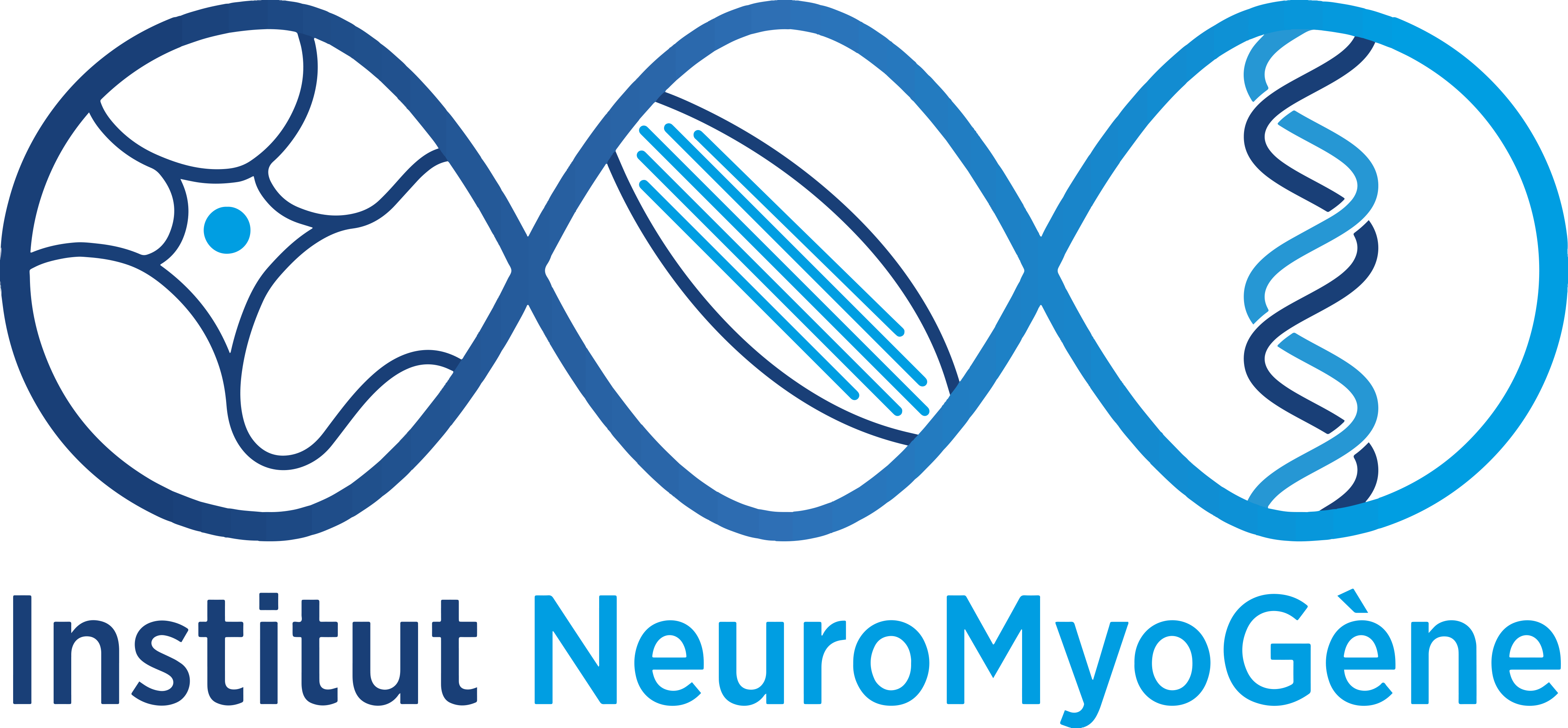The team develops a series of research topics dedicated to the maintenance of skeletal muscle homeostasis. Some discoveries and techniques developed by the team have direct implications for the diagnostic or the treatment of neuromuscular disorders. The team hosts clinicians that are involved in research projects aimed at developing innovative biomarkers and understanding the pathophysiology of neuromuscular disorders.

TEAM
- Laurent SCHAEFFER
PROFESSOR - Liudmila AFANASEVA
PhD Student - Edwige BELOTTI
POST-DOC UCBL1 - Julien CARRAS
EPHE student - Upasana CHATTERJEE
AI CNRS - Zélia CHAUVAUD
DOCTORANTE - Delia CICCIARELLO
POST-DOC CNRS - Thomas CHETOT
MCU-DVM - Agnes CONJARD-DUPLANY
INSERM RESEARCHER - Laurent COUDERT
POST-DOC HCL - Yann-Gaël GANGLOFF
CNRS RESEARCHER
- Emmanuelle GIRARD
RESEARCH ASSISTANT
- Shiyang HE
DOCTORANTEPhD student - Nicolas HUGO
RESEARCH ASSISTANT
- Arnaud JACQUIER
POST-DOC HCL UCBL1 - Nicolas LACOSTE
RESEARCH ASSISTANT - Pascal LEBLANC
CNRS RESEARCHER - Laetitia MAZELIN
INSERM RESEARCHER - Sandrine MOURADIAN
RESEARCH ASSISTANT - Peter MULLIGAN
INSERM RESEARCHER - Alexis OSSENI
POST-DOC UCBL1 - Alexandre PINTART
PhD Student - Shams RIBAULT
PhD Student - Valérie RISSON
RESEARCH ASSISTANT - Isabella SCIONTI
INSERM RESEARCHER - Thomas SIMONET
MCU-PH HCL UCBL1 - Julian THEURIET
PhD Student
CLINICIANS
- Emilien BERNARD
PH HCL - Françoise BOUHOURS
PH HCL - Philippe LATOUR
PH HCL - Rita MENASSA
PH HCL - Laurence MICHEL
PH HCL - Antoine PEGAT
PH HCL - Nathalie STREICHENBERGER
MCU-PH HCL UCBL1 - Juliette SVAHN
PH HCL - Carole VUILLEROT
MCU PH HCL

PROJECTS
MUSCLE STEM CELLS
Epigenetic regulation of muscle stem cell fate (Leader: Dr. Isabella Scionti)
Skeletal muscle has the unique ability to regenerate upon injury. This capacity relies on the presence of muscle stem cells (MuSCs), which are quiescent cells. In response to an injury, MuSCs activate, proliferate and undergo either commitment in the differentiation process or self-renewal to restore the pool of quiescent MuSCs. Our project aims at deciphering how MuSC fate transition is regulated, with particular focus on lysine demethylases (KDMs). Besides histone proteins, lysine methylation occurs also on other proteins, suggesting broader roles for these enzymes beyond chromatin modification. Thus, our objectives are to unveil the physiological role (at transcriptional and post-transcriptional level) of two lysine demethylases (LSD1 and PHF2) in regulating muscle stem cell fate choice, by using muscle stem cell-specific knock-out mouse models.
MUSCLE FIBERS
Histone variants (Leader: Dr. Edwige Belotti)
Muscle fibers are multinucleated, post-mitotic and long-lived cells, whose homeostasis is crucial for muscle function. While epigenetic changes and genomic stability have been demonstrated to be crucial for the maintenance of muscle fiber homeostasis, how these events are established and coordinated is poorly investigated. Several evidence indicates that histone variants, replacing conventional histones during postnatal life, play a key role in muscle plasticity. Thus, the project aims at dissecting the function of the histone variants in post-mitotic muscle fibers by using muscle-specific knock-out models.
TGFβ signaling (Leader: Dr. Laetitia Mazelin)
Muscle atrophy is a debilitating and life-threatening syndrome associated with chronic diseases such as cancer, myopathy, chronic obstructive pulmonary and kidney failure as well as aging sarcopenia. Members of the Transforming Growth Factor β family, TGF-β, myostatin, activin, are central regulators of muscle mass. The diversity of ligands and receptors prevents a precise description of the consequences of chronic TGFβ activation by classical gain and loss of function approaches. We have developed a genetic model allowing inducible muscle specific activation of chronic TGF-β signaling. New molecular signatures of muscle atrophy emerging from our study will provide future therapeutic perspectives for muscle wasting prevention and treatment.
mTOR signaling (Leader: Dr. Yann-Gaël Gangloff)
The dysregulation of mTOR signaling (mechanistic Target of Rapamycin) in skeletal muscle is a shared feature among several myopathies, therapeutic interventions (e.g., statins and glucocorticoids), and aging. Our laboratory has demonstrated a critical role of mTOR in the regulation of muscle integrity and whole-body homeostasis in mice. Overall, our work aims to understand the contribution of mTOR signaling in the pathophysiology of neuromuscular disorders.
HDAC6 (Leader: Dr. Alexis Osseni)
Our work has shown that by catalyzing tubulin and Smad3 deacetylation, HDAC6 respectively regulates acetylcholine receptor distribution and TGF signaling in muscle fibers, thereby controlling muscle mass and neuromuscular junction organization. Further investigation of HDAC6 in Duchenne Muscular Dystrophy and Spinal Muscle atrophy revealed new potential strategies of pharmacological treatment based on HDAC6 inhibitors for neuromuscular disorders. Altogether, our aim is to further understand the role of HDAC6 in skeletal muscle cells and develop the use of HDAC6 inhibitors in neuromuscular disorders.
MOTOR NEURON AND NEURO MUSCULAR JUNCTION
Protein misfolding disorders (Leader: Dr. Pascal Leblanc)
Misfolding disorders are characterized by the aggregation of specific cellular proteins with prion-like properties in the central nervous system or in surrounding tissues like muscles. Our aim is to investigate the molecular and cellular mechanisms by which associated pathological prion and prion-like proteins are formed, secreted and spread, thus exerting their neuro/muscular degenerative properties in the context of three pathologies (amyotrophic lateral sclerosis – ALS, sporadic inclusion body myositis and prion disorders). In tight collaborations with the neurologists from the Hospices Civils de Lyon, we also aim to characterize candidate biomarkers that could be used in diagnosis and disease monitoring.
Motoneuron and NMJ genetic diseases: (Leader: Dr. Arnaud Jacquier)
From genes to pathophysiology to treatment: motoneuron and NMJ pathologies involve more than 100 genes and many remain to be identified. The goal of this axis is to identify and characterize new genes involved in pathologies such as Charcot-Marie-Tooth disease, Spinal Muscle Atrophy and Congenital Myasthenic Syndromes. Human induced pluripotent stem cells (hiPS) provide a powerful mean for modeling motoneuron and NMJ genetic disorders to understand the underlying pathophysiology of newly identified genes and propose new treatments.
SELECTED PUBLICATIONS
- Muscle mTOR controls iron homeostasis and ferritinophagy via NRF2, HIFs and AKT/PKB signaling pathways.
Conjard-Duplany #, A. Osseni #, A. Lamboux, S. Mouradian, F. Picard, V. Moncollin, C. Angleraux, T. Dorel-Dubois, H. Puccio, P. Leblanc, B. Galy , V. Balter, L. Schaefer, Y.-G. Gangloff.
Cellular and Molecular Life Sciences (2025) https://doi.org/10.1007/s00018-025-05695-9 - LSD1 controls a nuclear checkpoint in Wnt/β-Catenin signaling to regulate muscle stem cell self-renewal.
Mouradian S.*, Cicciarello D.*, Lacoste N.*, Risson V., Berretta F., Le Grand F., Rose N., Simonet T., Schaeffer L.# and Scionti I.#.
Nucleic Acids Research (2024) doi.org/10.1093/nar/gkae060 - H2A.Z is involved in premature aging and DSB repair initiation in muscle fibers.
Belotti E.#, Lacoste N., Iftikhar A., Simonet T., Papin C., Osseni A., Streichenberger N., Mari P-O., Girard E., Graies M., Giglia-Mari G., Dimitrov S.#, Hamiche A.#, Schaeffer L.#.
Nucleic Acids Research (2024) doi.org/10.1093/nar/gkae020 - The new missense G376V-TDP-43 variant induces late-onset distal myopathy but not amyotrophic lateral sclerosis.
Zibold J., Lessard L., Picard F., Gruijs da Silva L., Zadorozhna Y., Streichenberger N., Belotti E., Osseni A., Emerit A., Errazuriz-Cerda E., Michel-Calemard L., Menassa R., Coudert L., Wiessner M., Stucka R., Klopstock T., Simonetti F., Hutten S., Nonaka T., Hasegawa M., Strom T., Bernard E., Ollagnon E., Urtizberea A., Dormann D., Petiot P., Schaeffer L., Senderek J. and Leblanc P.
Brain (2023) DOI: 10.1093/brain/awad410 - Spatial Transcriptomics Reveals Signatures of Histopathological Changes in Muscular Sarcoidosis.
Lequain H., Dégletagne C., Streichenberger N., Valantin J., Simonet T., Schaeffer L., Sève P., Leblanc P.
Cells (2023) DOI: 10.3390/cells12232747 - Novel Intronic Mutation in VMA21 Causing Severe Phenotype of X-Linked Myopathy with Excessive Autophagy-Case Report.
A. Pegat, N. Streichenberger, N. Lacoste, M. Hermier, R. Menassa, L. Coudert, J. Theuriet, R. Froissart, S. Terrone, F. Bouhour, L. Michel-Calemard, L. Schaeffer and A. Jacquier.
Genes (2022) DOI: 10.3390/genes13122245 - Immune-Mediated Rippling Muscle Disease Associated With Thymoma and Anti-MURC/Cavin-4 Autoantibodies.
J. Svahn , L. Coudert , N. Streichenberger, A. Kraut , A. Gravier-Dumonceau-Mazelier, L. Rotard , L. Calemard-Michel, R. Menassa, E. Errazuriz-Cerda, L. Chalabreysse, A. Osseni, C. Vial, L. Jomir, F. Tronc, D. Le Duy, E. Bernard, V. Gache, Y. Couté, V. Jacquemond, L. Schaeffer, P. Leblanc.
Neurology: Neuroimmunology & Neuroinflammation (2023) DOI: 10.1212/NXI.0000000000200068 - Pharmacological inhibition of HDAC6 improves muscle phenotypes in dystrophin-deficient mice by downregulating TGF-β via Smad3 acetylation.
A. Osseni, A. Ravel-Chapuis, E. Belotti, I. Scionti, Y-G. Gangloff, V. Moncollin, L. Mazelin, R. Mounier, P. Leblanc, B. J. Jasmin & L. Schaeffer.
Nature Communications (2022) DOI: 10.1038/s41467-022-34831-3 - Expanding the phenotypic variability of MORC2 gene mutations: From Charcot-Marie-Tooth disease to late-onset pure motor neuropathy.
A. Jacquier, S. Ribault, M. Mendes, N. Lacoste, V. Risson, J. Carras, P. Latour, A. Nadaj-Pakleza, T. Stojkovic, L. Schaeffer.
Human Mutation (2022) DOI: 10.1002/humu.24445 - Severe congenital myasthenic syndromes caused by agrin mutations affecting secretion by motoneurons.
A. Jacquier · V. Risson · T. Simonet 1,2 · F. Roussange · N. Lacoste · S. Ribault · J. Carras · J. Theuriet · E. Girard · I. Grosjean · L. Le Goff · S. Kröger · J. Meltoranta · S. Bauché · D. Sternberg · E. Fournier· A. Kostera-Pruszczyk ·E. O’Connor · B. Eymard · H. Lochmüller · C. Martinat · L. Schaeffer.
Acta Neuropathologica (2022) doi: 0.1007/s00401-022-02475-8 - The ESCRT-0 subcomplex component Hrs/Hgs is a master regulator of myogenesis via modulation of signaling and degradation pathways.
L. Coudert, A. Osseni, Y. G. Gangloff, L. Schaeffer and P. Leblanc.
BMC Biology (2021) doi: 10.1186/s12915-021-01091. - HDAC6 regulates microtubule stability and clustering of AChRs at neuromuscular junctions.
Osseni A, Ravel-Chapuis A, Thomas JL, Gache V, Schaeffer L, Jasmin BJ.
J Cell Biol (2020) doi: 10.1083/jcb/201901099. - H2A.Z is dispensable for both basal and activated transcription in post-mitotic mouse muscles.
Belotti E, Lacoste N, Simonet T, Papin C, Padmanabhan K, Scionti I, Gangloff YG, Ramos L, Dalkara D, Hamiche A, Dimitrov S and Schaeffer L.
Nucleic Acids Research (2020) doi: 10.1093/nar/gkaa157.
FUNDING
![]()
![]()




![]()

Address
Faculté de Médecine
3ème étage, Aile B
8 Avenue Rockefeller
F-69008 Lyon

